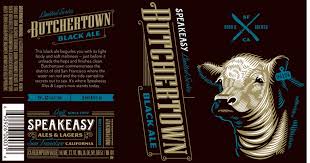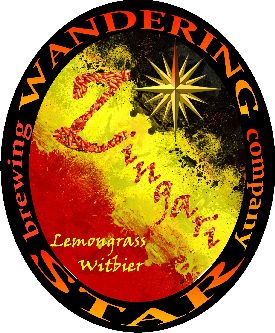Easygoing relaxant stays smoothly soft-tongued as oaken vanilla and dark chocolate seep into soothing bourbon warmth of wood-barreled Imperial Stout. Carbolic champagne yeast prickle yields burgundy-port undertones affecting black cherry, raisin, prune and blackberry tartness as well as subtle hazelnut-almond conflux. Dark-roasted stove-burnt coffee spell deepens complexity of 2011-brewed 10.7% alcohol mocha-bound digestif.
(HIGH & MIGHTY) FUMATA BIANCA SMOKED WHITE RYE BEER
(KLOSTER BRAUEREI) WEISSENOHE MONK’S CHRISTMAS
Thin German holiday lager lacks enthusiastic Yuletide punch and expectant seasonal spicing of wintry bock. Sedate dark-roasted coffee coats even subtler chocolate-cocoa-molasses triage. Unripe fig-date souring, lightest rye toasting and latent tobacco nip provide mildly soft-toned Extra Special Bitter profile.

BAXTER PAMOLA XTRA PALE ALE
Middling canned ale suffers from tinny astringency, bland crystal malting and understated stylistic approach. Mild roasted hop bittering usurps casual orange-red fruiting. Tealeaf, lemongrass and citrus undertones soften bread-floured bottom of sessionable straw-hazed springtime fodder. On tap at Ambulance, sour yellow-fruited dry body goes awry due to musty barley graining, rotten vegetal musk and dirty earthen bottom. Lemony pineapple tartness and infrequent herbal spell lose steam to crusty rusticity.
BAXTER STOWAWAY I.P.A.
First canned ale by Maine Brewery (circa 2011) is absolute hop-head delight! Piney Christmas tree waft matches “assertive hop profile” of bold full body. Expectant lemony grapefruit-orange rind bittering pervades juicy apricot-cherry-tangerine tang, picking up Granny Smith apple tartness alongside mineral-grained briskness. Honeyed caramel malting contrasts musty hop resin bottom of superfine fruit-enriched India Pale Ale.
BAXTER AMBER ROAD AMBER RED ALE
Simple Maine-based canned ale goes right down the middle stylistically. Nose-tingling deep-grained hop spices complement easygoing caramel-toasted barleymalts. Delicately brisk orange-grapefruit bittering belies slightly tinny mainstreamer.
SPEAKEASY BUTCHERTOWN BLACK ALE
Celebrating 2011’s 14th anniversary of respected Bay Area brewer, IPA-like hop-charred citric bittering outweighs Cascadian Dark Ale-like oats-flaked mocha nuttiness for stylistic Black IPA. Piney grapefruit-peeled expectancy picks up resinous walnut, black coffee, black currant, black licorice and Blackstrap molasses illusions along the way, coating the lingered black tar aftertaste.

SIXPOINT MAD SCIENTIST #3 – ALTBIER
Coming on like a lighter-tongued German schwarzbier with its lactic sour-milked black chocolate creaming and cocoa-dried caramel nuttiness, this so-called ‘top-fermented old beer’ or ‘dopplesticke lager’ follows up Mad Scientist’s initial ‘09 barleywine and ‘10s coffee bock. Ancillary stone-fruited spicing overlays tobacco-roasted French bread crusting, enhancing the resinous mocha motif.
WANDERING STAR ZINGARI LEMONGRASS WIT
Crisp moderate-bodied aperitif boasts lemongrass, cardamom and India fenugreek spicing (with a splash of coriander), retaining briny-salted citric zing. Delicate herbal pungency picks up dried fig-plum confluence, lemony tangerine-clementine tang and ancillary tarragon-thyme-rosemary seasoning for briskly clean-watered Belgian wit. Its subtle herbal complexities go beyond traditional stylistic genus.

GREENPORT HARBOR ANNIVERSARY ALE
Complex Belgian strong pale ale drapes creamy caramel malts and candi-sugared Belgian yeast atop a not-so-subtle grapefruit-peeled pine-combed juniper bittering. Refreshingly floral-spiced mint stint splinters citric foundation.

LAGUNITAS DOPPELWEIZEN
Nifty orange-hazed Bavarian-styled weizenbock creates Bananas Foster theme with its creamy rum-spiced banana-clove entry. Ancillary lemony pineapple-mango briskness receives mustard-seeded ethanol burn. Banana cream pie, banana bread and banana pudding illusions glide by.
STILLWATER STATESIDE SAISON
Crisply easygoing saison may have more character than brewers’ earliest farmhouse creations (as of December 2011). Spicy tangerine-apricot tang, lightly orange-spiced tartness and juicy pear proclivity contrast resinous earthen-hopped mineral-grained mustiness. Sunny summertime fruiting saturates shiny fresh-watered purity. Tertiary floral, pecan, and rye illusions scattered about.
